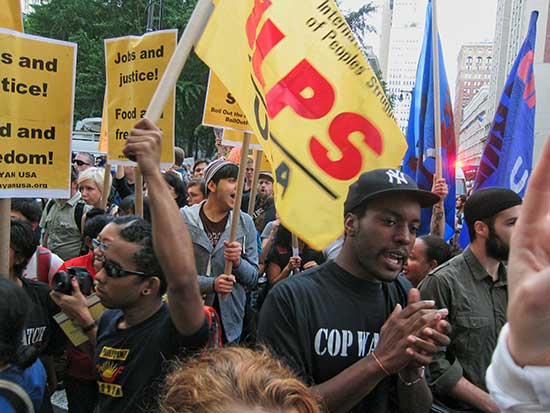Fueled by repression, no jobs
‘Occupy Wall Street’ ignites solidarity
By
Tony Murphy
New York
Published Oct 5, 2011 8:59 PM
|
Wall Street occupiers march on NYPD headquarters.
WW photo: G. Dunkel
|
On Oct. 7 a Haitian community group will march from Brooklyn across the Brooklyn Bridge and join the Occupy Wall Street encampment at Liberty Plaza in downtown Manhattan’s financial district. On Oct. 5 Columbia University students plan to walk out of classes and join a giant union march to the same site. A People of Color working group is now part of the encampment and meets regularly.
Occupy Wall Street is now officially New York’s center of protest — and is spreading like wildfire to other cities.
The police crackdowns and mass arrests of Occupy Wall Street protesters have breathed life into the phrase “repression breeds resistance.” They have also increased solidarity between Occupy Wall Street and unions, students and other groups.
Occupy Wall Street’s Labor Outreach committee, comprising some 50 people, has organized actions like a disruption on Sept. 22 of a Sotheby’s auction to support the art house’s locked-out workers. On Oct. 4 American Federation of State, County and Municipal Employees Local 372 held a City Hall rally with Occupy Wall Street support to protest layoffs of more than 700 school support staff.
The major news is that the city’s biggest unions — A FSCME DC 37, United Health Care Workers East (1199 SEIU), SEIU 32BJ, United Federation of Teachers, the United Auto Workers and the Transport Workers Union — have joined forces for a major march on Oct. 5 from City Hall to the Liberty Plaza site of Occupy Wall Street.
This followed the transit union’s great show of solidarity when it filed a lawsuit against the city for making union members drive city buses carrying arrested protesters to jail. The suit was filed two days after the arrest of nearly 800 people participating in a huge march across the Brooklyn Bridge on Oct. 1.
Calling the arrests “a blatant act of political retaliation,” Transport Workers President John Samuelsen said: “TWU Local 100 supports the protesters on Wall Street and takes great offense that the mayor and NYPD have ordered operators to transport citizens who were exercising their constitutional right to protest — and shouldn’t have been arrested in the first place.” (Daily News, Oct. 2)
Even before the Brooklyn Bridge arrests, there was a violent police crackdown on a Sept. 24 march. But that only made more people join the protest activities.
Widespread media coverage of protesters being maced in the eyes at that march galvanized outrage at a Sept. 30 march of thousands that targeted police headquarters. Placards read, “NYPD: Hands off Occupy Wall Street,” “Jail bankers, not protesters” and “NYPD protects bankers and billionaires.”
Coverage of the police crackdown included the movement’s use of the Internet to help identify Anthony Bologna as the offending officer, who not only pepper-sprayed protesters but also has outstanding lawsuits against him for similar behavior in the 2004 protests at the Republican National Convention.
All ages hit by unemployment
There’s no question that police attacks have helped fuel the growth of Occupy Wall Street. What’s also behind the dynamic growth of the movement, especially the spread of “Occupy” movements to other cities, is the devastating jobs crisis.
In addition to occupations in big cities like Washington, Boston, San Francisco, Chicago, Minneapolis and Baltimore, there are others in Memphis, Tenn.; Hilo, Hawaii; and McAllen, Texas.
According to the U.S. Labor Department, more than 2 million people have been jobless for 99 weeks or more — the cutoff point for unemployment benefits in states with the highest unemployment rates.
“I’m presently unemployed for the first time in my life, at 55 years old,” said Occupy Wall Street protester Albert Sgambati, who told AM New York that his teaching job at City University’s research foundation slipped from full to part-time and then to none last October, when the foundation lost funding. (Oct. 2)
At the same time, many students taking part in this movement are saddled with tens of thousands of dollars in debt with no job prospects. Another finding from the congressional report is that even though workers without a college education are more likely to be unemployed, jobless workers with bachelor degrees, and thus more school debt to pay off, are just as likely to become 99ers as jobless workers with high school diplomas.
On Oct. 2 protester Robert Cammiso held a sign at Liberty Plaza that read: “Arrested yesterday, back today.” On the other side it read: “Arrest one of us and two more will appear.”
The Occupy Wall Street members have shown great determination in the face of steady police harassment. As the unemployment crisis worsens, this dynamic movement will continue to grow.
Articles copyright 1995-2012 Workers World.
Verbatim copying and distribution of this entire article is permitted in any medium without royalty provided this notice is preserved.
Workers World, 55 W. 17 St., NY, NY 10011
Email:
[email protected]
Subscribe
[email protected]
Support independent news
DONATE


